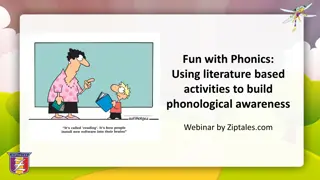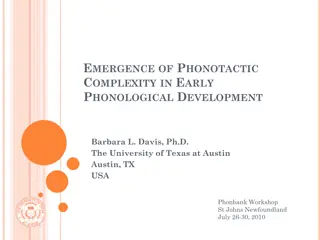Understanding Phonetic and Phonological Properties of Voicing in Polish Language
Explore the phonetic and phonological aspects of voicing in the Polish language, including the representation of contrasts, laryngeal distributions, and processes like neutralization and assimilation. Dive into topics like final obstruent devoicing, two-way voicing contrast, and the role of sonorants in the phonetic system.
Download Presentation

Please find below an Image/Link to download the presentation.
The content on the website is provided AS IS for your information and personal use only. It may not be sold, licensed, or shared on other websites without obtaining consent from the author. Download presentation by click this link. If you encounter any issues during the download, it is possible that the publisher has removed the file from their server.
E N D
Presentation Transcript
Eugeniusz Cyran KUL, Lublin 1
Aim: to understand Phonetic properties of voicing Phonological properties of voicing: Representation of contrast, e.g. b/p Distribution of laryngeal contrast Processes connected with voicing: Neutralization of contrast Final Obstruent Devoicing (FOD) Regressive Voice Assimilation (RVA) Progressive Voice Assimilation Role of sonorants as the target, source and barrier Relationship between phonology and phonetics 2
Two-way voicing contrast in Polish #_VV_V pi [pjit ] todrink rysa [r sa] scratch bi [bjit ] to hit ryza [r za] ream #_SVV_SV p otem [pw t m] fence, instr. oknie [ k b otem [bw t m] mud, instr. ognie [ g ] window, loc. ] fire, pl. __(S)V 3
Neutralization and Final Obstruent Devoicing a. [vaga]/[vak] waga / wag [ aba]/[ ap] aba/ ab scale, nom.sg./gen.pl. frog, nom.sg./gen.pl. b. [muzgu]/[musk] m zgu/ m zg brain, gen.sg./nom.sg. c. [d br ]/[dupr] dobro /d br goodness, nom.sg./gen.pl. __ (S) # 4
Neutralization and Regressive Assimilation a. [d x]/[txu] dech/tchu breath, nom.sg./gen.sg. b. [pr it ]/ [pr ba]prosi / pro ba to ask/a request c. [kfjad b g ji] kwiat begonii begonia flower d. [mEndrEk]/[mEntrk trka] m drek/m drka smart-aleck,/gs. __ (S)C 5
Distribution of laryngeal contrast in Polish a. b. c. ... C (S) V... ... C (S) # | Lar ... C (S) C... Lar Lar C = obstruent (S) = optional sonorant Lar = laryngeal contrast V = vowel 6
Binary representation of voice [+voi] / [voi] Simplified story: everything that is phonetically voiced has [+voi] everything that is phonetically voiceless has [-voi] /a/ | | | | /b/ /m/ /p/ [+voi] [+voi] [+voi] [ voi] 7
Neutralization and Regressive Assimilation in [ voi] systems a. liczba /lj i t - b a/ > [ljid ba] number [-voi] [+voi] b. abka / a b - k a/ > [ apka] frog, dim. [+voi] [-voi] 8
Neutralization and Final Devoicing (FOD) a. st g /stu g/ > [stuk] haystack [+voi] [-voi] default feature b. stuk /stu k/ > [stuk] knock [-voi] [-voi] default feature 9
Problems with binary representation It is able to describe everything - without providing much insight (understanding) Feature [+voi] behaves differently in sonorants and obstruents, e.g., asymmetry in: assimilations devoicing Being symmetrical, [ voice] ignores universally observed asymmetries between [+voi] and [-voi] (markedness). implications distribution (direction of neutralization) frequency of occurrence order of appearance in acquisition, etc. 10
Ways to avoid binarity problems Rule specificity and rule ordering, e.g.: [+voi] can spread only from obstruents, and only onto obstruents (assimilations) [+voi] spreads or is provided at the right moment Underspecificationof sonorants [+voi] is added later in derivation especially that it comes in handy sometimes 11
Markedness tendencies (puzzle?) unmarked marked (default) [+voi] Obstruents [-voi] [-voi] Sonorants [+voi] (Default rules, Markedness conventions) [+sonorant] [-sonorant] [+voi] [-voi] 12
The key to understanding voicing is in phonetics 13
Aerodynamic conditions on voicing oral and nasal exit P2 Larynx and vocal cords P1 > P2 P1 sonorants P1 > P2 Relaxing facial musles obstruents P1 = P2 Short closure Larynx Conclusion: Voicing of sonorants is spontaneous P1 Voicing of obstruents requires additional active gestures 14
Privativity Voiced sonorants should be unmarked unless they are voiceless Voiced obstruents should be marked - unless they are voiceless If there is no contrast, no marking is necessary 15
Phonetic categories based on VOT(Voice Onset Time) closure release VOT lag vowel vowel t [d] [t] [th] fully voiceless voiceless voiced unaspirated aspirated VOT lead CL Co CH 16
Voicing and Aspiration languages voicing aspiration Romance Germanic & Slavic voicedvoicelessvoiceless unaspiratedaspirated [d] [t] [th] /CL/ /Co/ /CH/ Hawaiian /to/ Polish /dL/ /to/ Icelandic /to/ Thai /dL/ /to/ Hindi /dL/ /to/ /tH/ /tH/ /tH/ [d ] = /dL+H/ 17
Privative models: Laryngeal Realism in Element Theory (GP) (Honeybone 2002, Gussmann 2007, Harris 2009) 3 types of voicing: sonorants Vo, So Spontaneous (universal phonetics) No marking!!! obstruents CL Active Marked obstruents Co Passive No marking (voicing is system dependent) Within one system, voicing in obstruents is either active or passive, never both!!! 18
Neutralization and Regressive Assimilation in Laryngeal Realism /lji to [ljid ba] number a. liczba - ba/ > /L/ bo koa/ b. abka frog, dim. / a b - > [ apka] /L/ 19
Neutralization and Final Devoicing in Laryngeal Realism go/ a. st g /stu g/ > [stuk] haystack /L/ b. stuk /stu ko/ > [stuk] knock 20
Cracow-Pozna Sandhi Voicing Warsaw Polish (WP) vs. Cracow-Pozna (CP) WP t-o CP g-o __V[+voi] d-o a. jak oni wk ad odr bny k-o __S[+voi] b. jak mo esz wk ad m j k-m t-m g-m d-m CP g-d __C[+voi] d-v WP c. jak dobrze wk ad w asny d. jak trudno wk ad sta y g-d d-v __C[ voi] k-t t-s k-t t-s 22
Formal analysis in binary feature models Spreading of [+voi] as in Regressive Voice Assimilation The target must be first neutralized The difference between WP and CP lies in the scope of the spreading rule wrt the source/trigger WP: spreading [+voi] from obstruents only CP: spreading [+voi] from any segment that has it (including vowels) 23
Binary feature analysis (Rubach 1996) WP CP a. /j a k # o i/ /j a k # o i/ [-voi] [-voi] [+voi] [-voi] [+voi] default b. /j a k # m o e / /j a k # m o e / [-voi] [-voi] [+voi] [-voi] [+voi] default c. /j a k # d o b e/ /j a k # d o b e/ [-voi] [+voi] [-voi] [+voi] 24
How about Laryngeal Realism? Polish is a voicing language (Co vs. CL) WP works perfectly Phonology Phonetic interpretation > [jak o i] a. /j a ko # oo i/ > [jak mo e ] b. /j a ko # mo o e / > [jag dob e] c. /j a ko # d o b e/ L CP is a nightmare! 25
Variation in laryngeal systems and a hypothesis phonetic categories Slavic & Romance [ph] [b] [p] L H Icelandic English H H Dutch??? 26
Laryngeal Relativism phonetic categories Warsaw Polish [ph] [b] [p] L Cracow-Pozna Polish H Voicing of obstruents is passive in CP, and active in WP 27
Final Devoicing in CP is interpretational not computational /oaboa/ > [ aba] ~ Final Devoicing is rather an absence of passive voicing /oabo/ > [ ap] Textbook question: Are we dealing with FOD or intervocalic voicing in [Zaba~Zap]? Textbook answer: FOD, because if there was a rule of intervocalic voicing, then /mapa/ *[maba] Wrong: we do not expect intervocalic delaryngealization /mapHa/ /mapoa/ > [*maba] in CP CP has Neutralization, but it takes place in the contexts {_#, _C} /mapH/ /mapo/ > [map] 28
Neutralization and Regressive Assimilation in Laryngeal Relativism a. liczba /lj i t - bo a/ > [ljid ba] to /H/ b. abka / a b - k a/ > [ apka] bo /H/ 29
What about Cracow-Pozna Sandhi voicing? 30
Just two more details The target of sandhi voicing must be /Co/ - either lexically neutral - or neutralized The source of voicing of obstruents: WP = /L/ CP = phonetically voiced context CL Co 31
A reminder of what happens in Warsaw Co must be voiceless in an L-system Phonology Phonetic interpretation /j a ko # oo i/ > [jak o i] > [jak mo e ] /j a ko # mo o e / > [jag dob e] /j a ko # d o b e/ L 32
In Cracow-Pozna, on the other hand Phonology Phonetic interpretation /j a k # oo i/ ko > [jag o i] H /j a k # mo o e / ko > [jag mo e ] H /j a k # do o b e/ ko > [jag dob e] H 33
Because in Cracow-Pozna [+voi] /Co/ must be voiced in front of V, S, C inside words and between words CoVo [dom] = Co#Vo [brad-ojtsa] CoSo [brat ] = Co#So [kub-r be] CoCo[gd ] = Co#Co[jag-dob e] Sandhi phonetics is a very apt term to apply to CP voicing 34
The main pillars of this analysis Reversed marking of obstruents in CP and WP: CP system = CH-Co WP system = Co-CL Warsaw Co cannot be passively voiced CP voicing requires: A system with marked voicelessness: CH-Co Passive voicing Neutralization CH Co / {_#, _C} 35
Advantages of this analysis Sonorants remain unmarked Their voicing is only of phonetic nature and importance No special phonological rule is required for CP sandhi voicing No rule ordering either Sandhi voicing = word-internal voicing in CP 36
Consequences of this analysis and Laryngeal Relativism There is no phonological voicing in CP Only spontaneous and passive Final Obstruent Devoicing can be: Phonological (in Warsaw system) Interpretational (in Cracow-Pozna system) Assimilations can be: Phonological Spreading of /H/ or /L/ Neutralization (deletion of /H/ or /L/) Interpretational (WP /toxou/, CP /jakodoob e/) Full voicing of obstruents, FOD and RVA are not adequate criteria for claiming that a given language has [+voi] The relation between phonological categories (H,L) and phonetic categories (b-p-ph) is by and large arbitrary! 37
Between phonology and phonetics Sound system (e.g. Laryngeal system) Phonology Phonetics -privative categories Representation & Computation Phonetic categories & Phonetic interpretation -universal phonetic principles -universal principles of phonetic interpretation -(un)licensing -(de)composition: spreading, delinking -system specific conventions -sociolinguistic modifications 38
Aim: to understand Phonetic properties of voicing Phonological properties of voicing: Representation of contrast, e.g. b/p Distribution of laryngeal contrast Processes connected with voicing: Neutralization of contrast Final Obstruent Devoicing (FOD) Regressive Voice Assimilation (RVA) Progressive Voice Assimilation Role of sonorants as the target, source and barrier Relationship between phonology and phonetics 39
C V C V C V | | | | H | k | H oNo You! 40























